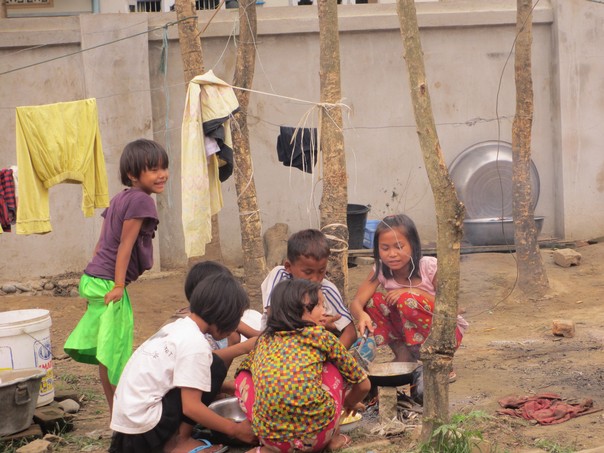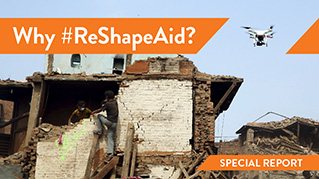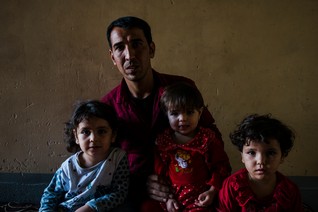-


Tens of thousands of people have fled fighting between Burma’s government and the rebel Kachin Independence Army (KIA) since the breakdown of a ceasefire in June 2011. On a trip to Kachin State last month we visited many of the displacement camps dotted around the state capital.
There are 100,000 displaced people in Kachin State, a northern region bordering China. But more than half live in the area held by the rebel Kachin Independence Organisation (KIO) and the government is not allowing international access.
-


This photo shows a Kachin woman we met in a camp about 30 minutes’ drive outside the Kachin State capital, Myitkyina. She and her family were displaced from their village 60 miles away following fighting in August 2011. Before the conflict she used to harvest rice and tend to livestock, but in the camp she has no such livelihood opportunities. This camp was managed by a local Catholic organisation and the residents receive rice and beans from the U.N. World Food Programme, but they struggle to find money for anything more than this basic, repetitive ration.
But at least, in the area controlled by the government, aid does get to the displaced. The government is not allowing aid to get through to camps in areas held by the KIO. We heard about camps that are desperate for food, shelter materials and warm clothes. Up by the Chinese border temperatures in these camps can drop very low. While we were visiting the U.N. had been told that they could send a humanitarian convoy to the camps in the non-government controlled areas – then at the last minute the government changed its mind on sending the convoy, and people’s hopes were dashed again.
-


These colourful bead purses, handbags and key-chains were made by women engaged in one of the only livelihood projects we came across. They were using this new skill to help pay for basic items such as vegetables, meat, curry spices or medicines. Sadly such projects are in very short supply. Donor governments are treating this situation as an emergency humanitarian response, and not allocating funding for livelihood opportunities - yet people have been displaced for nearly two years.
-


This teenage girl is preparing lunch for her five siblings at a Buddhist monastery camp in Waingmaw, Kachin. She cooks in a little make-shift kitchen outside her family’s bamboo shelter. The possibility of it catching fire is a real concern.
The lack of livelihood opportunities leads to desperation for many families, particularly in the camps not getting assistance. Sadly there has been a major increase in trafficking of Kachin women and girls for forced marriages and prostitution across the border into China since the conflict re-started in 2011.
-


As the conflict and displacement goes on, there is an increasing need for projects to give hope and opportunities to the young. There has been a disturbing rise in drug abuse among young people in the government-controlled areas, as they feel increasingly hopeless about their future. In the rebel-controlled areas there is still a serious problem of child recruitment by armed groups.
-


These displaced children are able to attend school in the government-controlled areas, but we were told there was some discrimination by teachers against displaced children. In the non-government controlled areas schools are rarely available for displaced children. Many have missed nearly two years of schooling.
-


This family’s home was destroyed during fighting in August 2012. This picture captures four generations of the family. Fifteen family members live in one barrack style row house. Before the war, the family ran a small business and a barber shop. In the camp, they earn a small living by providing barber services.
Thousands of people who fled the conflict are living with host families who have generously taken them in, but after a few months they start to run out of resources. The government does not permit aid agencies to help host families, even though this would be one way of avoiding yet more people being forced into camps.
-


This barrack style shelter is typical of the housing provided to displaced families in camps around Myitkyina and Waingmaw. This camp is home to almost 100 families. Each shelter is partitioned into spaces measuring about 9’ x 9’ (3 metres squared) and houses 8-10 families. The shelters are made of bamboo, which keeps them cool during the summer heat. But they don’t provide much privacy.
Families we met said their relatives in camps in the KIO-controlled areas live in single family homes made with bamboo. Due to the remoteness and altitude of some of the camps in the KIO-controlled areas, getting building supplies to the camps is quite a challenge. During the rainy season, which lasts from May to October, it is very windy and wet. Roads are impassable and supplies need to be transported by mules. These bamboo homes are not always adequate against the freezing rain or wind.
The displaced people we met had no hope of returning to their homes for years. Even if a deal was reached, many of their villages have been taken over by the army and their families, land-mines have been laid and would need to be cleared, and they would need help with rebuilding their destroyed houses and livelihoods.
-


A Kachin refugee boy wraps himself in a blanket at a refugee camp at Man Si township in Kachin State January 19, 2013. REUTERS/Kaung Htet







































